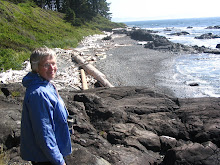Why is it important for students involved in an inquiry learning project to share their new understandings?
By this point in their inquiry learning process, students have become very knowledgeable about their topic. They may have created a research essay or a powerpoint presentation. However, as they grapple with the issues of how to share their new knowledge with an audience, it will consolidate the learning that they have done. Depending how they choose to share, they may receive feedback which will help them to improve their learning process or product. (For example, if they posted a powerpoint presentation on Slideshare, they could ask for people to make comments on the presentation. If they created a video and posted it to YouTube, people could make comments.) As students work on sharing about their topic, it moves them to begin the process of transfer of inquiry skills into other areas. In a science inquiry process using open inquiry, Knodt (2009) discovered that as students met regularly for inquiry projects, they began to transfer the language and habits of thinking into other subjects. They were able to reflect using metacognition.
Another reason for sharing the learning is in order to build the class into a community of learners. Kuhlthau (2007) suggests that as students collaborate and then listen to each other's presentations, rich funds of knowledge are created for that community.
As I shared my Twitter workshop, it helped me to understand my own practice of using Twitter. Things I had only understand intuitively, I was able to put into words. As well, my Twitter workshop helped to build my community of learners as I encouraged the class to begin to discover the value of Twitter.
How does the sharing phase of inquiry learning take place?
This aspect of the sharing is interconnected with many of the other question words. However, I am choosing to look at how the teacher supports the learning to share process. The teacher will be discovering along with the students (especially when it comes to using new technologies like Prezi or Voicethread). The teacher will need to scaffold learning and provide just the right amount of support. Part of this learning may be the provision of rubrics to help students see all the requirements for various ways of sharing learning. For those new to inquiry, the teacher may simply give them the rubrics. However, as students become more adept at inquiry, teacher and students together can create the rubrics. (Create Rubrics for Project Activities http://rubistar.4teachers.org/index.php?screen=NewRubric§ion_id=2#02)
The teacher may also provide models for students to refer to in making their sharing creations. I mentioned earlier the posters that my students created to take to camp. I made a poster ahead of time to determine how much information and how many pictures could be included on a small poster. I showed the students the poster as a model. Part of the sharing (and later reflecting on the sharing) process is to reflect on the presentations that other students have made. I did this several times after Science Fairs or Heritage Fairs. After I had marked all the displays, I invited the class to come on a Gallery Walk with me. I took them to the top 3 or 4 displays. Then I asked them what they noticed. They shared their observations. Then I mentioned anything that they had not touched upon. When students returned to their own displays, I could hear them reflect on what they had done well and what they could do better.
Sometimes during the sharing phase of inquiry learning, teachers will need to encourage students to revisit some of the other phases. Inquiry learning is a recursive process. More information may need to be retrieved or a new product created especially if a new audience will be coming in. (During Science and Heritage Fairs, my students noticed that they needed to adjust their mini-speeches depending on the age group visiting their displays.)
For my Twitter workshop, I did look at information that other people had shared about teaching Twitter. I noticed that sometimes instructors of Twitter workshops would say, "Please welcome Ms. White to Twitter." When I would click on Ms. White, she would have no tweets. Even those students who had a tweet, had followed no one. So I learned from others and structured my Twitter workshop in order to address these concerns.
Visit blog post entry #5 for the discussion questions and reference list for this look at the Sharing phase of inquiry learning. (Click here.)
The Loser's Club
6 years ago





No comments:
Post a Comment